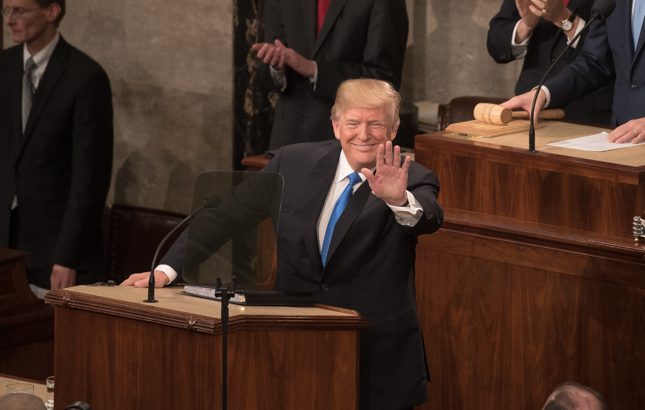Inside the State of the Union
By • February 1, 2018 0 557

There’s a big-deal event that happens every year in the Capitol that some Georgetowners may be tempted to ignore or dismiss. It’s the State of the Union speech — known to journalists and political wonks as SOTU.
Article II, Section 3, of the U.S. Constitution requires the president to periodically “give to the Congress Information of the State of the Union, and recommend to their Consideration such measures as he shall judge necessary and expedient.”
Presidents George Washington and John Adams gave their reports in front of Congress in New York City. But Thomas Jefferson started a long tradition of submitting it only in writing. In 1913, Woodrow Wilson started what has become a tradition of delivering the report in person. Harry Truman was the first to use live, televised broadcasts to widen the speech’s reach.
Nowadays, the SOTU usually takes place on the last Tuesday of January, accompanied by pomp and ceremony. It has become a way for the president to gather visible support from sitting lawmakers for his (so far) coming year’s agenda. And it’s an opportunity for journalists to see, up close and personal, and possibly talk to the most important people in government.
Congressional journalists crowded into assigned seats and standing room in the press gallery above the speaker’s podium Jan. 30 for President Trump’s first SOTU. Few, even of the most callous reporters, would deny the thrill of being just feet away from the president, the vice president, the speaker of the House and most of the Cabinet secretaries. In front of the assembly of representatives and senators are justices of the Supreme Court and the top military brass who make up the Joint Chiefs of Staff.
Reporters are aware that one Cabinet officer is missing: the one selected to be the sole survivor in case of a catastrophic attack on Congress during the SOTU.
The press eagerly watches the room’s dynamics. Who crowded the seats along the main aisle to schmooze the Cabinet officers when they parade down and to shake hands with the president? This year, there were decidedly fewer who had come early to reserve seats along the aisle, unlike the past eight years when Democrats, especially from the Black Caucus, packed the aisle seats on both sides to take a selfie with President Barack Obama.
The press also enthusiastically watches who is sitting with whom (there are no assigned seats). Republicans sitting in the right-hand Democratic section were easily identified when they stood up to cheer the president’s words. Their Dem colleagues largely sat on their hands during the entire speech. The Republicans were smiling, looking confident and happy and often standing and cheering loudly.
The press in the gallery received a written transcript of the speech and carefully followed along. President Trump, like President Obama, rarely diverged from the written text, which he was following on teleprompters to his left and right.
The Republican “gentlemen” of Congress wore red and blue ties; the “gentlewomen” wore similarly colored suits and dresses. Many of the Democratic women wore black, as dour as their visages. Many of the members of the Hispanic and Black Caucuses wore kente ties and sashes — colorful African weavings — “for solidarity,” Rep. Luis Vicente Gutiérrez (D-Illinois) told this reporter before the speech.
A while later, Gutiérrez visibly left the floor after Trump’s remarks about gang members. “You’d think the MS-13 was the only gang in America the way the president talked,” he told The Georgetowner later in an interview in Statuary Hall. “He [Trump] was making it sound as if all immigrants are violent criminals.”
Gutiérrez was just one of dozens of representatives that the press could interview without the usual monitoring from their communications staff, making the SOTU a special event for reporters. After the speech, the press can join their TV colleagues (who are barred from the House and Senate chambers) to chat and listen in on live interviews being given by the networks, stationed around the room under the Capitol dome.
The long-term impact of SOTUs is questionable. “The president has little power to change congressional minds and win support for controversial bills with rhetoric alone. Even the public won’t likely move much,” according to Jeffrey Jones, a senior editor at Gallup.
Still, there is the immediate reaction and some enduring messaging. The president focused on his four pillars of immigration reform. Even Democrats applauded (one of the few times) when Trump emphasized his support for higher wages, infrastructure and paid family leave.
SOTU phrases can take on a life of their own. In George W. Bush’s address of January 2002, the first one delivered after 9/11, he labeled North Korea, Iran and Iraq as an “axis of evil.”
Trump said: “It only took a year to build the Empire State Building. Now it takes 10 years to get a permit to build a road.”
He also said: “We’re all Dreamers now.” We’ll see if that one sticks.

